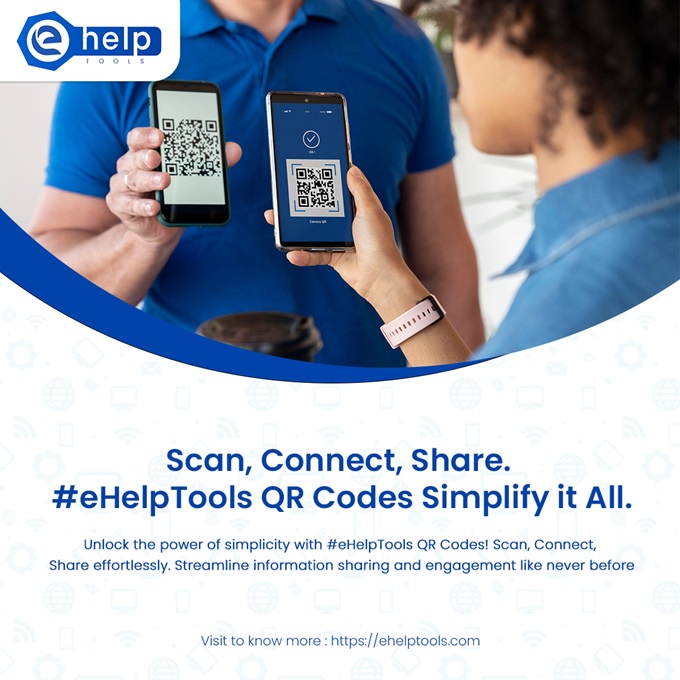In our rapidly evolving digital landscape, Quick Response (QR) codes have become an integral part of our daily lives, seamlessly blending the physical and digital realms. Originally developed in 1994 by Denso Wave, a subsidiary of Toyota, QR codes have come a long way from their humble beginnings in automotive manufacturing. In this blog post, we will explore the intricacies of QR codes, delving into their working principles, myriad uses, and the numerous advantages they bring to the table.
Understanding the Mechanics of QR Codes:
At its core, a QR code is a two-dimensional barcode that can store a wealth of information. Unlike traditional barcodes, which are linear, QR codes are arranged in a square grid, enabling them to store data both horizontally and vertically. The data within a QR code can range from simple alphanumeric text to more complex information like URLs, contact details, or even Wi-Fi network credentials.
The working of a QR code involves the use of black squares arranged on a white square grid. These black squares encode the information, and the pattern is read by an imaging device, such as a smartphone camera. The code is then deciphered using specialized software, allowing users to access the embedded information.
Uses of QR Codes:
Contactless Payments:
QR codes have revolutionized the way we make payments. Mobile payment systems like Apple Pay, Google Pay, and various banking apps utilize QR codes to facilitate secure and convenient transactions. Users can simply scan a merchant's QR code or display their own for others to scan, enabling swift and cashless payments.
Marketing and Advertising:
QR codes have become a powerful tool in marketing campaigns. Companies embed QR codes in their advertisements, product packaging, or even storefronts to provide consumers with instant access to additional information. This seamless transition from the physical to the digital world enhances user engagement and streamlines the customer experience.
Product Tracking and Authentication:
QR codes are employed in supply chain management for tracking products from manufacturing to delivery. Additionally, they serve as a means of product authentication, allowing consumers to verify the authenticity of a product by scanning its QR code.
Event Ticketing:
QR codes have replaced traditional paper tickets at events, concerts, and cinemas. Attendees can simply present their electronic tickets on their smartphones, eliminating the need for physical tickets and reducing the environmental impact.
Healthcare:
In the healthcare sector, QR codes are used for patient identification, medical record access, and medication management. They provide a secure and efficient way to manage and share critical health information.
Advantages of QR Codes:
Efficiency and Speed:
QR codes significantly enhance efficiency by enabling quick data retrieval. Whether it's accessing a website, making a payment, or checking in at an event, the process is expedited through a simple scan, saving both time and effort.
Versatility:
QR codes are versatile in terms of the information they can store. From text and URLs to contact details and geographical coordinates, QR codes provide a flexible solution for a wide range of applications.
Cost-Effective:
Implementing QR codes is cost-effective for businesses. Printing QR codes on marketing materials, packaging, or tickets is more economical than traditional methods, and the digital nature of QR codes eliminates the need for physical infrastructure like card readers.
Contactless and Hygienic:
The rise of QR codes has been accelerated by the global shift towards contactless interactions. Especially in the wake of the COVID-19 pandemic, QR codes offer a hygienic alternative to physical transactions and interactions.
User Engagement:
QR codes facilitate seamless interaction between physical and digital spaces, enhancing user engagement. Whether it's accessing exclusive content, participating in promotions, or obtaining additional product details, QR codes make the experience more interactive and enjoyable.
Read more: Bar Code Generator | Exploring Essential Online Tools: QR code to Audio Conversion
Conclusion:
In conclusion, QR codes have evolved into a ubiquitous and indispensable technology in our interconnected world. Their simplicity, versatility, and efficiency make them a valuable asset across various industries. From streamlining payments to enhancing marketing strategies, QR codes have transformed the way we interact with information. As technology continues to advance, the role of QR codes is likely to expand even further, embedding themselves deeper into the fabric of our digital existence. Embracing the power of QR codes is not just about scanning black and white squares; it's about unlocking the limitless possibilities they bring to our fingertips. Create free QR code from Ehelptools online.
Source: https://sites.google.com/view/ehelptool/blog/understanding-qr-codes-working-uses-advantages


No comments yet